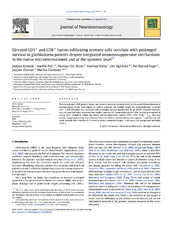Elevated CD3+ and CD8+ tumor-infiltrating immune cells correlate with prolonged survival in glioblastoma patients despite integrated immunosuppressive mechanisms in the tumor microenvironment and at the systemic level
Kmiecik, Justyna; Poli, Aurélie; Brons, Nicolaas H.C.; Waha, Andreas; Eide, Geir Egil; Enger, Per Øyvind; Zimmer, Jacques; Chekenya, Martha
Peer reviewed, Journal article
Published version
Permanent lenke
https://hdl.handle.net/1956/7668Utgivelsesdato
2013-11-15Metadata
Vis full innførselSamlinger
Originalversjon
https://doi.org/10.1016/j.jneuroim.2013.08.013Sammendrag
We characterized GBM patients' tumor and systemic immune contexture with aim to reveal themechanisms of immunological escape, their impact on patient outcome, and identify targets for immunotherapy. Increased CD3+ T-cell infiltration was associated with prolonged survival independent of age, MGMT promoter methylation and post-operative treatment that implies potential for immunotherapy for GBM. Several mechanisms of escape were identified: within the tumor microenvironment: induced CD8+CD28−Foxp3+ Tregs that may tolerize antigen presenting cells, elevated CD73 and CD39 ectonucleotidases that suppress T-cell function, and at the systemic level: elevated IL-10 levels in serum, diminished helper T-cell counts, and upregulated inhibitory CTLA-4.

